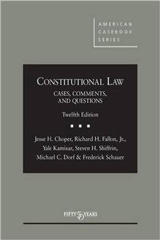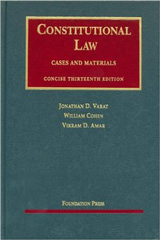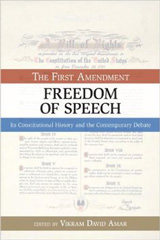For us law professors, the recent per curiam decision by the U.S. of Court Appeals for the Fifth Circuit in Umphress v. Hall provides some excellent “teachable moments.” Uncomplicated in its facts—a Texas state judge fears being sanctioned by a state judicial ethics board for conducting marriage ceremonies for opposite-sex but not same-sex couples—the case raises a series of knotty procedural and substantive legal questions. In issue-spotting fashion, we identify and grapple with some of those problems, including ones that required resolution up to this point, and others that may require resolution down the road depending on how the case proceeds. In today’s installment in this two-part series, we take up below several interesting and complex threshold “justiciability” matters (that is, questions that go to whether a federal court can or should entertain a particular dispute), and in Part Two we will unearth and analyze some complex legal questions that go to the substantive merits of the dispute between this judge and the Texas state regulators.
First, some background: Texas specifies that only certain classes of persons are permitted to perform weddings in the state, as well as the obligations such individuals assume when they take on that role. State law provides that only the following individuals are allowed to conduct a marriage ceremony: (1) a licensed or ordained Christian minister or priest; (2) a Jewish rabbi; (3) a person who is an officer of a religious organization and who is authorized by the organization to conduct a marriage ceremony; and (4) a current, former, or retired federal judge or state judge. (Notably the law does not require any particular member of these groups to conduct marriage ceremonies.) State law also prohibits “a person authorized to conduct a marriage ceremony” “from discriminating on the basis of race, religion, or national origin against an applicant who is otherwise competent to be married.” State law goes on to specify a particular remedy to redress impermissible discrimination on these grounds by state judges in particular: “[o]n a finding by the State Commission on Judicial Conduct that a person has intentionally violated” the non-discrimination provision, “the commission may recommend to the supreme court that the person be removed from office.” Finally, in an amendment effective 2015, state law exempts some church officiants from part of the non-discrimination requirement by providing that “clergy or minister may not be required to solemnize any marriage . . . if the action would cause the . . . individual to violate a sincerely held religious belief.”
Brian Umphress, a county judge in Texas, brought a federal-court lawsuit against the Texas State Commission on Judicial Conduct. He sought declaratory and injunctive relief preventing the Commission from enforcing against him Canon 4A(1) of the Texas Code of Judicial Conduct, which states that “[a] judge shall conduct all of the judge’s extra-judicial activities so that they do not cast reasonable doubt on the judge’s capacity to act impartially as a judge.” In his complaint, Umphress asserted that he faced a threat of discipline because he is a member of a church that teaches marriage exists only for one man and one woman that and homosexual conduct is immoral, and because he refuses (given his religious beliefs) to perform same-sex weddings even though he performs weddings for heterosexual couples. When he filed his lawsuit, Umphress was preparing a reelection campaign with a platform declaring that the Supreme Court’s 2015 decision in Obergefell v. Hodges, invalidating state-law bans on same-sex marriage, was incorrect.
At the time of his lawsuit, Umphress had not been subject to any actual discipline by the Commission. In filings in the district court in response to the lawsuit, the Commission asserted that it had no present plans to bring any disciplinary action against Umphress because of his opposition to same-sex marriage or refusal to perform same-sex weddings or related activities. But Umphress argued to the district court that he reasonably feared being disciplined because several months previously, the Commission had issued a public warning against Dianne Hensley, a Texas justice of the peace, for also publicly refusing (also on religious grounds) to officiate at same-sex weddings but officiating at weddings of heterosexual couples. In that warning, the Commission took the view that Hensley’s conduct cast doubt on her capacity to act impartially in the courtroom. Hensley sued the Commission in state court seeking a declaratory judgment that, as a matter of Texas state law, judges do not violate Canon 4(A)(1) by opposing same-sex marriage or refusing to perform same-sex weddings even if they perform opposite-sex weddings.
Umphress’s federal lawsuit raised different claims. Umphress contended that he cannot constitutionally be required to perform same-sex weddings and that Obergefell compels no such result; that the Commission’s (apparent) interpretation and application (as he feared would occur) of Canon 4(A)(1) violated the First Amendment’s Speech Clause; and that any application Canon 4(A)(1) to judges for refusal to perform same-sex weddings would violate the First Amendment’s Free Exercise Clause. The district court dismissed Umphress’s entire case on the basis that there existed no facts supporting a current or imminent injury to give rise to Article III standing and on the related basis that the claims were not ripe. In addition, the district court ruled that even if there were standing and the claims were ripe, it would abstain under the Pullman-abstention doctrine (a federalism-focused set of principles in which federal courts decline to entertain federal challenges to state laws in order to give state courts a chance to interpret such laws in the first instance), given Hensley’s pending action in state court on the application of the Canon.
Following the district court’s decision dismissing Umphress’s case, there was further activity in Hensley’s lawsuit. After resolution, all the way up to the Supreme Court of Texas, of some procedural issues, but before any decision on the merits, the Commission rescinded its disciplinary warning and then moved for dismissal of Hensley’s state court case as moot. That is where things stood when the Fifth Circuit issued earlier this month its decision in Umphress’s own appeal.
Reversing the district court, the Fifth Circuit panel held Umphress had met requirements of standing and that his claims were ripe. It further determined that because state-court litigation in Hensley’s case was unlikely to yield an answer to the underlying question as to the meaning of Texas state law (because the Commission was no longer pursing discipline against her and was asking the state courts to dismiss her action), Pullman abstention was no longer warranted. But because the Fifth Circuit shared the district court’s concern that resolving Umphress’s federal claims absent a clearer sense of whether and to what extent the Texas law even sought to impose sanctions against judges in Umphress’s position was imprudent, the Fifth Circuit decided to use “certification” (a process whereby federal courts can ask state supreme courts to clarify unresolved questions of state law that may arise in federal-court cases) to ask the Supreme Court of Texas this question: “Does Canon 4A(1) of the Texas Code of Judicial Conduct prohibit judges from publicly refusing, for moral or religious reasons, to perform same-sex weddings while continuing to perform opposite-sex weddings?”
Even though the case is in a holding pattern until the Texas Supreme Court responds to the Fifth Circuit’s certified question, there is much from Umphress that we can learn and teach.
First is that standing and constitutional ripeness (two seemingly separate doctrinal requirements a plaintiff in federal court must meet before his case can be adjudicated) often ask nearly the same questions, and each of the two inquiries can be shoehorned into the other. In Umphress, for example, the key question is whether there exists a significant enough likelihood that the Texas Judicial Conduct Commission may go after him because of his discriminatory practice. That question helps resolve whether he is suffering an “injury in fact” for Article III standing purposes because his fear of enforcement is real and objectively reasonable (rather than speculative and subjective) such that he is being harmed. The Fifth Circuit said his fear of actual enforcement was real and reasonable, so that he had standing. But then the court said that his claims are ripe, rather than premature, essentially (again) because his fear of enforcement was sufficiently reasonable. As the court put it, “for the same reasons Umphress has standing to bring his claims, his claims are ripe for review.” Umphress thus illustrates (as do some Supreme Court cases such as Susan B. Anthony v. Driehaus that Umphress cited extensively) that standing and ripeness in many situations overlap, almost to the point of asking the very same question twice. The reality is that in some cases like Umphress, there is really no need for both doctrines, and that the result can be just as easily argued for and explained in terms of ripeness as standing.
Second, in reaching the conclusion that there was a sufficient likelihood of enforcement to satisfy standing/ripeness, the Fifth Circuit placed a significant amount of weight on the fact that the Commission, when given the chance, declined to promise to Umphress that he would never be subject to discipline for his discriminatory practices in the marriage setting. That reasoning by the Fifth Circuit seems to us questionable, or at least overblown. How could the Commission feel comfortable promising Umphress a permanent free pass when to do so would bind future Commission membership, even if present membership has no intention of going after him. And as a formal analytic matter, the question of whether Umphress faces a sufficiently high likelihood of enforcement is different than whether the government is willing to guarantee non-enforcement. To be sure, the latter might be relevant to the former, but the Fifth Circuit seemed to suggest that the latter would as a general matter tend to be dispositive, which doesn’t strike us as correct.
A third and even more dubious move the Fifth Circuit apparently makes with regard to justiciability is also worth raising. The Umphress court, citing seeming well-settled Fifth Circuit precedent (Speech First v. Fenves), said that in deciding whether a sufficient likelihood of enforcement has been demonstrated to clear the standing/ripeness hurdles, a court needs to know whether a plaintiff is challenging a law only as applied to him, or on its face. According to Fifth Circuit precedent:
Whereas “[t]here must be some evidence that [a] rule would be applied to the plaintiff in order for that plaintiff to bring an as-applied challenge,” that is not the case for facial challenges. Instead, “when dealing with pre-enforcement challenges to recently enacted (or, at least, non-moribund) statutes that facially restrict expressive activity by the class to which the plaintiff belongs, courts will assume a credible threat of prosecution in the absence of compelling contrary evidence.”
But that Fifth Circuit doctrine reflects basic confusion about justiciability doctrine. To be sure, the facial/as-applied distinction does affect the standing inquiry in a case and opens the standing door more widely in facial (as distinguished from as-applied) challenges. But that relaxation of standing rigidity in facial challenges relates to the general rule against third-party standing; a plaintiff in a facial challenge can raise the rights of others even if his own conduct is constitutionally proscribable. But that has nothing to do with Article III standing’s requirements of an injury-in-fact and ripeness. Each plaintiff, to satisfy Article III, must show sufficient likelihood of enforcement against him in order to invoke the federal court, even before we get to the (facial/as-applied) question of whose rights may be invoked. And courts can’t “assume a credible threat of enforcement” as a general matter, because that would relieve a plaintiff of his burden to establish Article III justiciability pre-requisites. And in any event, the burden of proving this credible threat (whatever that burden may be and who bears it) is exactly the same regardless of whether, once Article III standing is satisfied, we permit a plaintiff to invoke the rights of third parties in a facial challenge. In short, the Fifth Circuit seems not to understand the basic difference between constitutionally irreducible Article III standing requirements (including injury in fact and ripeness), on the one hand, and prudential standing doctrines (such as the presumption against invocation of third-party rights), on the other. In Umphress the Fifth Circuit found Judge Umphress’s challenge to the Commission’s authority to be as-applied and not facial, such that the odd and mistaken Fifth Circuit Fenves doctrine here was beside the point, but Umphress still offers a good occasion to discuss and debunk the misguided Fifth Circuit Fenves rule that Umphress discusses but ultimately does not invoke.
Fourth, just as Umphress illustrates the overlap between standing and ripeness, so too it illustrates the overlap between Pullman abstention and certification. Pullman applies most uncontroversially when state litigation is already pending and holds the promise of resolving the unclear state law, whereas certification can create the state-court proceeding (at the state supreme court level) even in the absence of existing state-court proceedings. But notwithstanding their procedural differences, they come from the same analytic place (the problem arising from unclear state law and the possibility that a federal court will answer a federal question that ultimately does not need answering) and try to resolve the problem in the same way (wait for a definitive state-court interpretation that will help clarify, or obviate the need to address, the federal issues). Another noteworthy aspect of the Pullman doctrine’s application in Umphress is the fact that although the Fifth Circuit reversed the district court’s invocation of Pullman abstention, the appeals court explicitly made clear that this reversal was based not on any error committed by the district court, but instead because of a development after the district court had ruled but before the Fifth Circuit had weighed in (namely, the actions by the Commission to withdraw discipline in the Hensley matter and request dismissal of the state-court litigation in which state law might otherwise get clarified). This is a nice reminder that reversal of a lower court doesn’t always mean the lower court did something wrong. Another example of this phenomenon occurs when the Supreme Court reverses a lower court’s faithful adherence to past Supreme Court precedent on point, simply because the Supreme Court has decided to overrule that precedent. In such circumstances, the Supreme Court admonishes lower courts to follow its past rulings that are on point, even if most reasonable observers could predict that those rulings are ripe for overturning by the high Court itself. In such circumstances the lower court is reversed, but it had done exactly what the Supreme Court had told it was the right thing to do.
The substantive merits of Umphress’s federal claims raise many interesting and important questions of their own, questions we take up in Part Two of this two-part series.









